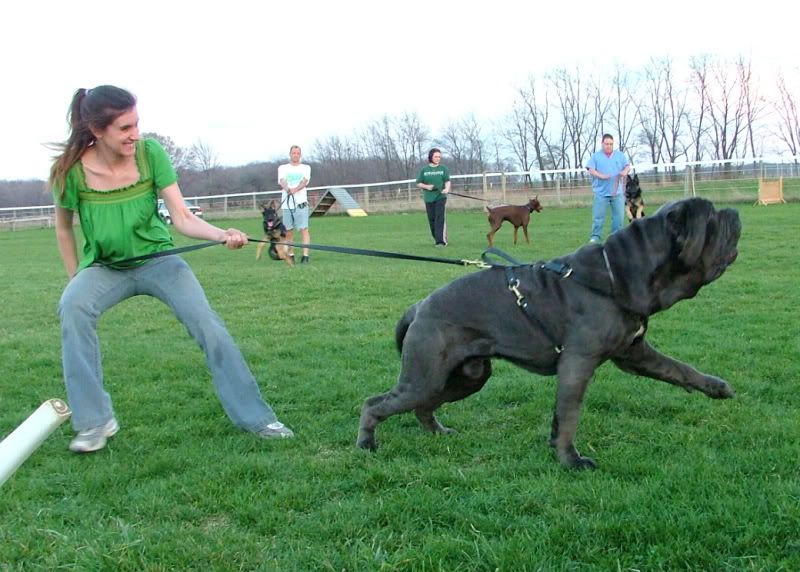Comment to Butch PP Training
-
[quote1315517226=Igmuska] Are these your first sessions? I am not a fan of the technique the decoys are using. That is also some interesting line agitation, far too close together for my liking (for molossers). As a handler, best thing to do is have both hands on the leash. Get yourself a nice 6 foot leather, and a correction collar on some sort of tab. Looping your hand in the leash is a death sentence. You are trapping you and your dog if something happens. Get in the habit of two hands, loop in the right, with the loop around your thumb and across your palm with your fingers grasping it. This makes a lock, while allowing you to totally release the leash in a hurry if need be, as there is no way you can physically pull your thumb through your palm. Your left hand guides, lets out or reels in, and corrects the dog. If you get a correction collar on a separate tab, you can "out" your dog, reinforce it, and mean it on the first try, not cranking his neck around with the flat a few dozen times. Agitation and bite work is rough enough on the cervical vertebrae, don't make it worse... Here is a video about proper leash technique as I have described. This is for OB, but the right hand lock technique is the same. http://vimeo.com/179230 Your stance is good, feet wide apart, bent at the knees, with your left leading. Stay upright, do not bend at the waist, this gives the advantage to the dog and destroys the back. If you need more power, lean into your back bracing leg, in almost a sit. Pivot on you weight baring leg, and point with your lead leg. You can and should be able to complete a 360 spin in this position if you ever need to direct or follow your dog once alerted. If you place your right hand on your hip, this gives you added support. By "sitting" and pushing down with the right hand, you can control most beasts. Here is a member, showing good form and holding a dog that outweighs her by quite a bit. This technique will provide you with superior control of your dog. The only thing I need to address in this photo is that she could have more weight on her back foot (she is moving in this photo also), but considering this dog has over 50+ pounds on her, she does a great job.
 [/quote1315517226]
Igmuska, BETSY? Yes THIS last video is actually his VERY first session as well as my own. If you'll notice in the beginning they were actually trying to tell me about the lean back. As far as the leash they use a flat with a short leash BEFORE they go to the 6 foot then the 30. I have another story, (KINDA BRAGGING). My boy hasn't had many sessions but he's shown that he has the will. There was a gentleman in the class ACTUALLY the advanced class that asked if he could try his dog for the first time on a 30 foot send. The trainers explained that not every dog will go without that close connection to their owner and his dog did not, a Bandog. So, the trainers explained further that you may have to start running with your dog to get him going, well the owner of the Bandog did this and the dog still stopped short. One of the trainers told me to bring my boy and send him to show the Bandog owner up and he went each time, 3 times. I also have video of that but I'm afraid to put it up because I KNOW I screwed up, LOL. With all that being said, I'm a beginner, my dog as well to a certain extent but he's not afraid. I was just hoping for some comfirmation from MD that I had a pretty good boy and all for the most part have said good dog poor decoys. I'm still hoping someone can tell me a LITTLE about what makes a good or bad decoy because I don't know what to look for.
Thank you again
[/quote1315517226]
Igmuska, BETSY? Yes THIS last video is actually his VERY first session as well as my own. If you'll notice in the beginning they were actually trying to tell me about the lean back. As far as the leash they use a flat with a short leash BEFORE they go to the 6 foot then the 30. I have another story, (KINDA BRAGGING). My boy hasn't had many sessions but he's shown that he has the will. There was a gentleman in the class ACTUALLY the advanced class that asked if he could try his dog for the first time on a 30 foot send. The trainers explained that not every dog will go without that close connection to their owner and his dog did not, a Bandog. So, the trainers explained further that you may have to start running with your dog to get him going, well the owner of the Bandog did this and the dog still stopped short. One of the trainers told me to bring my boy and send him to show the Bandog owner up and he went each time, 3 times. I also have video of that but I'm afraid to put it up because I KNOW I screwed up, LOL. With all that being said, I'm a beginner, my dog as well to a certain extent but he's not afraid. I was just hoping for some comfirmation from MD that I had a pretty good boy and all for the most part have said good dog poor decoys. I'm still hoping someone can tell me a LITTLE about what makes a good or bad decoy because I don't know what to look for.
Thank you again
